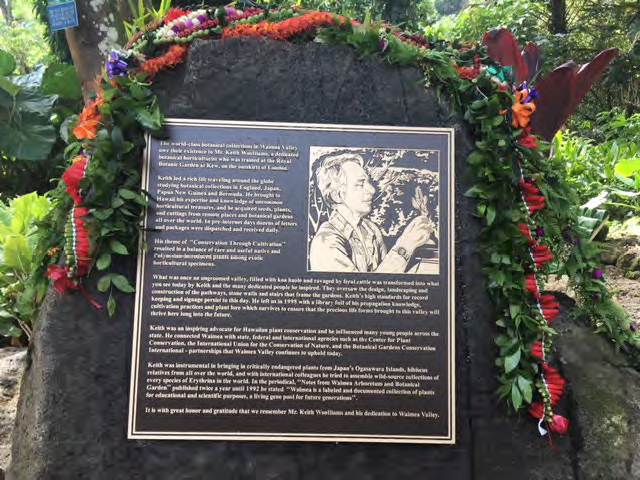On October 12, 2018, Waimea Valley held a dedication honoring Mr. Keith Woolliams, the Director of Waimea Arboretum and Botanical Garden from 1974-1998. Below is an excerpt from the speech his daughter, Angela Woolliams gave that day.
It’s funny to think that none of this would’ve happened without a chance meeting between Dad and Jun Hedemann at a botanical conference in 1974. At this time, Jun introduced him to Charlie Pietsch Jr. who was planning to build a new Botanical Garden in Waimea Valley. After Dad shared his dream of creating a rescue center for threatened species around the world, Charlie offered him the chance to develop a world-class,
conservation-based botanical garden that would enhance the beauty of Waimea’s lower valley and be able to be enjoyed in a meaningful way by the public. Dad was no fool and jumped at the opportunity, moving the family from Kauai to Oahu two months later.
From the start, he laid out the garden’s landscape under a “tropical forest” concept with trees providing coverage for the various plants used in Waimea’s general landscaping and in the botanical collections grouped by location, family and/ or genus. Boy, wasn’t that an adventure, providing stories of times like when the lilikoi fruit blocked the newly laid irrigation pipe leading to Pond 1 much to Dad’s onsternation. I’m sure a few choice words were said while the whole thing had to be dismantled and put back together.
Due to rising sea levels and the rapid global decline of plant species, Dad decided to focus his botanical efforts upon all kinds of tropical plants, with a particular emphasis upon those from remote, obscure island ecosystems not a focus for major botanical gardens – places like Madagascar, the Ogasawara Islands in Japan, Fiji, and Papua New Guinea.
In his view, the best way to preserve these and Hawaiian endemic flora was through “conservation through cultivation” – a guiding principle by which Waimea’s collections would form a living “gene pool” from which endangered plant species would be cultivated and distributed widely around the world. This became one of Waimea’s primary roles which he fostered through his development of connections with over 150 local,
national and international botanical or conservation contacts, particularly the International Union for the Conservation of Nature and Natural Resources or the IUCN, and the establishment of Waimea’s seed and plant exchange program.
The importance of his approach to conservation can be seen in the case of two particularly notable stories. First, upon his arrival in Hawai`i in 1971, Dad heard about efforts by various botanical gardens to propagate the Kokia cookei tree from seeds and cuttings from the only remaining tree on Molokai. He decided to try his hand at it while at Kauai’s Pacific (now National) Tropical Botanical Garden and later while at Waimea. Finally, he met success when one of his Waimea cuttings began to grow. After a fire destroyed the parent tree on Molokai a few years later, these, to our knowledge, became the only living specimens to exist in Hawai`i.
Similarly, when the guerrilla war in Cuba broke out, Dad and Dr. Kirchoff, a consultant of Waimea in 1974 and an Erythrina specialist, became concerned about the loss of the native erythrina due to ongoing fighting. Since sending mail directly to Cuba wasn’t allowed in 1979, Dad reached out to his international
contacts for seeds or cuttings for the three Cuban species. When no answer came through normal channels, he decided – as Dad would – to reach out to Cuban dictator Fidel Castro directly by sending a letter addressed to him in care of the Russian Embassy. Must to his surprise, a package arrived from Cuba in August 1980
containing seeds for two of the requested plants, but only that of the Erythrina elenae survived the journey to become a part of Waimea’s collections.
Dad recognized that the backbone of the exchange program and Waimea’s public education efforts is the accuracy of the botanical inventory and signage, so he made sure to drill into his staff the key adage of “Taxonomic accuracy is next to Godliness”. A true perfectionist, it was common to find him with
multiple books spread out in the library or on his desk while cross-referencing information or rifling through his filing cabinet full of clippings and other information he had saved “just in case” he needed it for informational signs, speeches or articles.
One quest that became the main focus of Dad’s academic research for many decades was the search for the original Hibiscus rosa sinensis species. The late Dr. Yukio Jotani, a professor from Japan who studied hibiscus, brought this question to his attention during his 1976 visit to Waimea. Ever the scientist at
heart, Dad joined with Jotani-sensei on this academic search. After years of scouring texts from China and Europe, some as old as 300 AD; multiple international trips; and cross-water mail correspondence collaboration, the pair concluded that the most likely candidate is the Tawada Single Red hibiscus that is
in Waimea’s current collections.
It’s amazing to realize that many of the collections you see around you would be next to impossible to establish today due to increased regulations, climate change and the continued loss of species around the world. There are many stories that demonstrate this, but one prime example is the Ogasawara Island
collection, which Dad collected over the course of two trips to the region. The area has now been established as a World Heritage site, making it illegal to collect any cuttings or seeds from native flora there. This means that Waimea may be the only collection of Ogasawara plants outside of Japan.
We’re so grateful for the ongoing efforts of the Waimea botanical staff … through their efforts, there are endangered species from Waimea’s collections that are flourishing in Sydney Zoo, the San Diego Zoo, Huntington Botanical Garden in California, and other botanical institutions around the world. It is
comforting to see Dad’s tangible legacy in such reliable hands. Yet, this place is only one half of his legacy. Perhaps the more important part is seeing his guiding principles, mission and vision applied in the plant-related careers of those… he met, taught, and/or inspired. We’re humbled, honored and deeply grateful for this recognition of his contribution to conservation and his hands-on efforts to create the beauty surrounding us today. Mahalo nui loa to you all for joining our ohana on this special day.



